A rank ordering of particles and their use in calculating the dimensionless gravitational coupling constant, sorted by how closely they are to the combinatorial hierarchy’s 4th entry (the third entry being 137 corresponding to electromagnetic coupling aka the fine structure constant):
